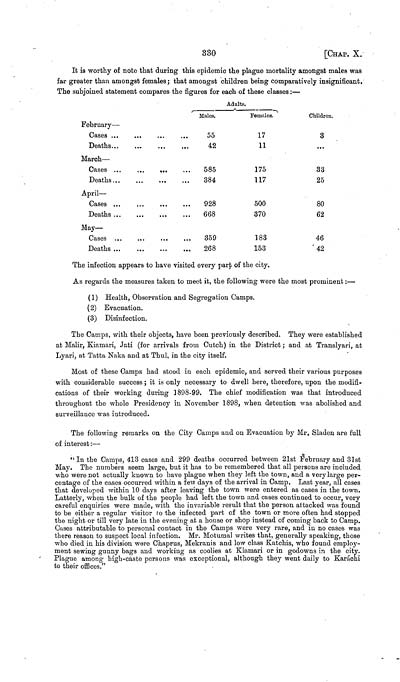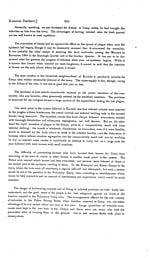Medicine - Disease > Bombay plague: being a history of the progress of plague in the Bombay presidency from September 1896 to June 1899
(412) Page 330
Download files
Individual page:
Thumbnail gallery: Grid view | List view

330 [CHAP. X.
It is worthy of note that during this epidemic the plague mortality amongst males was
far greater than amongst females; that amongst children being comparatively insignificant.
The subjoined statement compares the figures for each of these classes:-
Adults.
Males.
Females.
Children.
February-
Cases ...
55
17
3
Deaths...
42
11
...
March-
Cases ...... . .....
585
175
33
Deaths...
384
117
25
April-
Cases
928
500
80
Deaths ............
668
370
62
May-
Cases ...
359
183
46
Deaths ...
268
153
42
The infection appears to have visited every part of the city.
As regards the measures taken to meet it, the following were the most prominent:-
(1) Health, Observation and Segregation Camps.
(2) Evacuation.
(3) Disinfection.
The Camps, with their objects, have been previously described. They were established
at Malir, Kiamari, Jati (for arrivals from Cutch) in the District; and at Translyari, at
Lyari, at Tatta Naka and at Thul, in the city itself.
Most of these Camps had stood in each epidemic, and served their various purposes
with considerable success; it is only necessary to dwell here, therefore, upon the modifi-
cations of their working during 1898-99. The chief modification was that introduced
throughout the whole Presidency in November 1898, when detention was abolished and
surveillance was introduced.
The following remarks on the City Camps and on Evacuation by Mr. Sladen are full
of interest:-
"In the Camps, 413 cases and 299 deaths occurred between 21st February and 31st
May. The numbers seem large, but it has to be remembered that all persons are included
who were not actually known to have plague when they left the town, and a very large per-
centage of the cases occurred within a few days of the arrival in Camp. Last year, all cases
that developed within 10 days after leaving the town were entered as cases in the town.
Latterly, when the bulk of the people had left the town and cases continued to occur, very
careful enquiries were made, with the invariable result that the person attacked was found
to be either a regular visitor to the infected part of the town or more often had stopped
the night or till very late in the evening at a house or shop instead of coming back to Camp.
Cases attributable to personal contact in the Camps were very rare, and in no cases was
there reason to suspect local infection. Mr. Motumal writes that, generally speaking, those
who died in his division were Chaprus, Mekranis and low class Katchis, who found employ-
ment sewing gunny bags and working as coolies at Kiamari or in godowns in the city.
Plague among high-caste persons was exceptional, although they went daily to Karchi
to their offices."
It is worthy of note that during this epidemic the plague mortality amongst males was
far greater than amongst females; that amongst children being comparatively insignificant.
The subjoined statement compares the figures for each of these classes:-
Adults.
Males.
Females.
Children.
February-
Cases ...
55
17
3
Deaths...
42
11
...
March-
Cases ...... . .....
585
175
33
Deaths...
384
117
25
April-
Cases
928
500
80
Deaths ............
668
370
62
May-
Cases ...
359
183
46
Deaths ...
268
153
42
The infection appears to have visited every part of the city.
As regards the measures taken to meet it, the following were the most prominent:-
(1) Health, Observation and Segregation Camps.
(2) Evacuation.
(3) Disinfection.
The Camps, with their objects, have been previously described. They were established
at Malir, Kiamari, Jati (for arrivals from Cutch) in the District; and at Translyari, at
Lyari, at Tatta Naka and at Thul, in the city itself.
Most of these Camps had stood in each epidemic, and served their various purposes
with considerable success; it is only necessary to dwell here, therefore, upon the modifi-
cations of their working during 1898-99. The chief modification was that introduced
throughout the whole Presidency in November 1898, when detention was abolished and
surveillance was introduced.
The following remarks on the City Camps and on Evacuation by Mr. Sladen are full
of interest:-
"In the Camps, 413 cases and 299 deaths occurred between 21st February and 31st
May. The numbers seem large, but it has to be remembered that all persons are included
who were not actually known to have plague when they left the town, and a very large per-
centage of the cases occurred within a few days of the arrival in Camp. Last year, all cases
that developed within 10 days after leaving the town were entered as cases in the town.
Latterly, when the bulk of the people had left the town and cases continued to occur, very
careful enquiries were made, with the invariable result that the person attacked was found
to be either a regular visitor to the infected part of the town or more often had stopped
the night or till very late in the evening at a house or shop instead of coming back to Camp.
Cases attributable to personal contact in the Camps were very rare, and in no cases was
there reason to suspect local infection. Mr. Motumal writes that, generally speaking, those
who died in his division were Chaprus, Mekranis and low class Katchis, who found employ-
ment sewing gunny bags and working as coolies at Kiamari or in godowns in the city.
Plague among high-caste persons was exceptional, although they went daily to Karchi
to their offices."
Set display mode to: Large image | Zoom image | Transcription
Images and transcriptions on this page, including medium image downloads, may be used under the Creative Commons Attribution 4.0 International Licence unless otherwise stated. ![]()
| India Papers > Medicine - Disease > Bombay plague: being a history of the progress of plague in the Bombay presidency from September 1896 to June 1899 > (412) Page 330 |
|---|
| Permanent URL | https://digital.nls.uk/74586792 |
|---|




